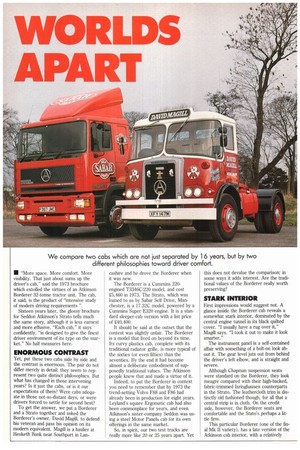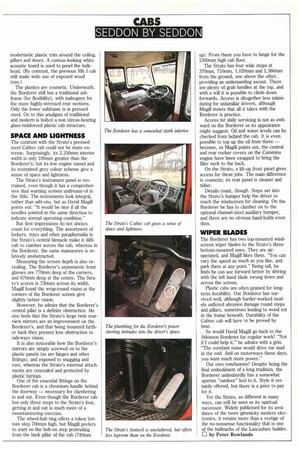WORLDS APART
Page 52

Page 53

If you've noticed an error in this article please click here to report it so we can fix it.
We compare two cabs which are not just separated by 16 years, but by two different philosophies toward driver comfort
• "More space. More comfort. More visibility. That just about sums up the driver's cab," said the 1973 brochure which extolled the virtues of an Atkinson Borderer 32-tonne tractor unit. The cab, it said, is the product of "intensive study of modern driving requirements ".
Sixteen years later, the glossy brochure for Seddon Atkinson's Strato tells much the same story, although it is less earnest and more effusive. "Each cab," it says confidently, "is designed to give the finest driver environment of its type on the market." No half measures here.
ENORMOUS CONTRAST
Yet, put these two cabs side by side and the contrast is enormous. The pair do not differ merely in detail; they seem to represent two quite distinct philosophies. But what has changed in those intervening years? Is it just the cabs, or is it our expectations of them? Were cabs adequate in those not-so-distant days, or were drivers forced to settle for second best?
To get the answer, we put a Borderer and a Strato together and asked the Borderer's owner, David Magill, to defend his veteran and pass his opinion on its modern equivalent. Magill is a haulier at Hesketh Bank near Southport in Lan cashire and he drove the Borderer when it was new.
The Borderer is a Cummins 220engined T3346C/220 model, and cost 25,460 in 1973. The Strato, which was loaned to us by Sabar Self Drive, Manchester, is a 17.32C model, powered by a Cummins Super E320 engine. It is a standard sleeper-cab version with a list price of 240,400.
It should be said at the outset that the contest was slightly unfair. The Borderer is a model that lived on beyond its time. Its curvy plastics cab, complete with its traditional radiator grille, is more typical of the sixties (or even fifties) than the seventies. By the end it had become almost a deliberate embodiment of supposedly traditional values. The Atkinson people knew that and made a virtue of it.
Indeed, to put the Borderer in context you need to remember that by 1973 the trend-setting Volvo F88 and F86 had already been in production for eight years. Leyland's square Ergoinatic cab had also been commonplace for years, and even Atldnson's sister-company Seddon was using a steel Motor Panels cab for its own offerings in the same market.
So, in spirit, our two test trucks are really more like 20 or 25 years apart. Yet this does not devalue the comparison; in some ways it adds interest. Are the traditional values of the Borderer really worth preserving?
STARK INTERIOR
First impressions would suggest not. A glance inside the Borderer cab reveals a somewhat stark interior, dominated by the central engine tunnel in its black quilted cover. "I usually have a rug over it," Magill says. "I took it out to make it look smarter."
The instrument panel is a self-contained affair with something of a bolt-on look about it. The gear level juts out from behind the driver's left elbow, and is straight and severe.
Although Chapman suspension seats were standard on the Borderer, they look meagre compared with their high-backed, fabric-trimmed Isringhausen counterparts in the Strato. The leathercloth trim is distinctly old fashioned though, for all that a central strip is in cloth. On the credit side, however, the Borderer seats are comfortable and the Stato's perhaps a little firm.
This particular Borderer (one of the final Mk II variety), has a late version of the Atkinson cab interior, with a relatively modernistic plastic trim around the ceiling, pillars and doors. A curious-looking white acoustic board is used to panel the bulkhead. (By contrast, the previous Mk I cab still made wide use of exposed wood trim.) The plastics are cosmetic. Underneath, the Borderer still has a traditional ash frame (for flexibility), with mahogany for the more highly-stressed rear sections. Only the lower subframe is in pressed steel. On to this amalgam of traditional and modern is bolted a non stress-bearing glass-reinforced plastic cab structure.
SPACE AND LIGHTNESS
The contrast with the Strato's pressedsteel Cabtec cab could not be more extreme. Surprisingly, its 2,250mm interior width is only 100mm greater than the Borderer's; but its low engine tunnel and its restrained grey colour scheme give a sense of space and lightness.
The Strato's instrument panel is restrained, even though it has a comprehensive dual warning system undreamt-of in the Atki. The instruments look integral, rather than add-ons, but as David Magill points out: "It would be nice if all the needles pointed in the same direction to indicate normal operating condition."
But first impressions do not always count for everything. The assortment of lockers, trays and other paraphernalia in the Strato's central binnacle make it difficult to clamber across the cab, whereas in the Borderer, the same manoeuvre is relatively unobstructed.
Measuring the screen depth is also revealing. The Borderer's asymmetric front glasses are 770mm deep at the corners, and 670mm deep at the centre. The Strato's screen is 730mm across its width. Magill found the wrap-round vision at the corners of the Borderer screen give slightly better vision.
However, he admits that the Borderer's central pillar is a definite obstruction. He also feels that the Strato's large twin rearview mirrors are an improvement on the Borderer's, and that being mounted further back they present less obstruction to sideways vision.
It is also noticeable how the Borderer's mirrors are simply screwed on to the plastic panels (as are hinges and other fittings), and exposed to snagging and rust, whereas the Strato's external attachments are concealed and protected by plastic fairings.
One of the essential fittings on the Borderer cab is a chromium handle behind the doorway — necessary for clambering in and out. Even though the Borderer cab has only three steps to the Strato's four, getting in and out is much more of a mountaineering exercise.
The wheel-hub ring offers a token bottom step 700mm high, but Magill prefers to start on the bolt-on step protruding from the back pillar of the cab (740mm up). From there you have to lunge for the 1300mm high cab floor.
The Strato has four wide steps at 370mrn, 710rrnn, 1,020mm and 1,360min from the ground, one above the other, providing an undemanding ascent. There are plenty of grab handles at the top, and with a will it is possible to climb down forwards. Access is altogether less intimidating for unfamiliar drivers, although Magill insists that all it takes with the Borderer is practice.
Access for daily servicing is not as awkward on the Borderer as its appearance might suggest. Oil and water levels can be checked from behind the cab. It is even possible to top up the oil from there — because, as Magill points out, the central and rear rocker covers on the Cummins engine have been swapped to bring the filler neck to the back.
On the Strato, a lift-up front panel gives access for these jobs. The main difference is cosmetic; its rear panel is cleaner and tidier.
Details count, though. Steps set into the Strato's bumper help the driver to reach the windscreen for cleaning. On the Borderer he has to clamber on to the optional channel-steel auxiliary bumper, and there are no obvious hand-holds even then.
WIPER BLADES
The Borderer has two top-mounted windscreen wiper blades to the Strato's three bottom-mounted ones. They are airoperated, and Magill likes them. "You can vary the speed as much as you like, and park them at any point." Being tall, he finds he can see forward better by driving with the left hand blade swung down and across the screen.
Plastic cabs are often praised for longterm durability. Our Borderer has survived well, although harder-worked models suffered abrasion damage round steps and pillars, sometimes leading to wood rot in the frame beneath. Durability of the Cabtec cab will have to be proved by time.
So would David Magill go back to the Atkinson Borderer for regular work? "Not if I could help it," he admits with a grin. "The constant noise would drive me mad in the end. And on motorways these days, you want much more power."
Our own conclusions? Despite being the final embodiment of a long tradition, the Borderer undoubtedly has a somewhat spartan "outdoor" feel to it. Style it certainly offered, but there is a price to pay for it.
Yet the Strata, so different in many ways, can still be seen as its spiritual successor. Widely publicised for its avoidance of the more gimmicky modern electronics, it retains more than a vestige of the no-nonsense functionality that is one of the hallmarks of the Lancashire builder. El by Peter Rowlands
































































































































